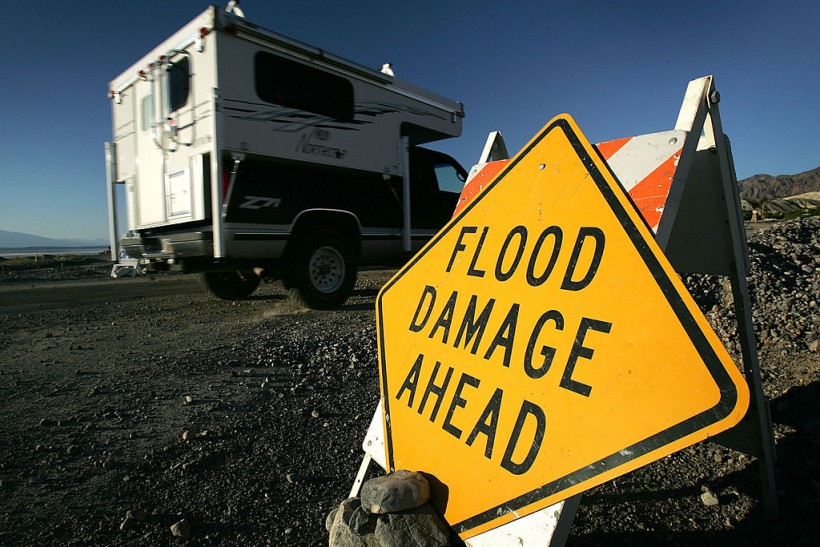
Death Valley is temporarily closed to visitors as Hilary caused extensive damage.
Death Valley sustained significant damage from Hilary, including pavement and a wet, unstable landscape. As a result, what was known to be the driest national park had to be temporarily closed to visitors indefinitely.
Death Valley National Park Closes Temporarily
With only 2.2 inches of rain falling there annually on average, Death Valley, stretching from California to Nevada, is the driest national park in the US. It is also known as the world's hottest region and a zone of extremes. Death Valley is far more vibrant than its name suggests; travelers are intrigued by the secrets of the wildlife that has managed to survive in this desolate and dry environment.
Many people travel to Death Valley to take in the breathtaking scenery, which includes canyons and alluvial fans. These features are primarily the result of flooding, which can occasionally be quite dramatic and have a considerable impact on infrastructure used by people.
It might therefore come as a bit of a shock to find that the Death Valley National Park has been closed for more than two weeks already, though not because of the extreme heat that the region has been experiencing this summer. The drenching aftermath of Hurricane Hilary is to blame.
Hilary Aftermath
The National Park Service recently announced that August 20 was the wettest day ever recorded at Furnace Creek in Death Valley when 2.2 inches of rain were observed.
A park that receives so little rain was hit by a storm that spilled so much rain that the delicate vegetation was severely damaged. Major roads in the park have extensive damage, including undercutting and pavement degradation, and many of the roadways are littered with debris.
Wet and Fragile Landscape
Death Valley has experienced devastation of this nature for the past two years in a row. Additionally, the park was closed in August 2022 due to then-record rainfall when maintenance was being done on the facilities, trails, and roadways.
All that work has just started again. The NPS stated that even though all paved roads from the 2022 flood damage have been fixed, more work still needs to be done in the wilderness and this most recent storm has further increased the damage.
The timing of the current closure is still uncertain. The park stated on Labor Day that they do not currently have an estimated time for when the roads would reopen due to the magnitude of Tropical Storm Hilary's effects, the extensive amount of debris on roads, and sections of pavement damage.
Joshua Tree National Park is accessible to the south for those seeking a national park desert getaway, as the National Park Service suggested. A fire ban was in effect there on Wednesday night as a reminder of how harsh desert terrain can be.
Also Read: California Reservoirs at High Water Levels Following Tropical Storm Hilary
Hoping for Superblooms
Regarding superblooms, the park stated that in certain deserts, floods produce lovely flowers in a matter of weeks. However, the average daily high temperature in Death Valley in August is over 115 degrees Fahrenheit, so while some plants may begin to green up, no blooms are anticipated any time soon.
It is too soon to say whether the water from this summer will cause a superbloom in the spring of 2024. Superblooms are uncommon occurrences that frequently call for both rain in the autumn or winter before and no drying wind in the spring.
Related Article: Labor Day Sees 72,000 Stranded in Burning Man Festival Flood
© 2024 NatureWorldNews.com All rights reserved. Do not reproduce without permission.

![Climate Change is Reducing Dust Levels Worldwide as Arctic Temperature Warms [Study]](https://1471793142.rsc.cdn77.org/data/thumbs/full/70320/280/157/50/40/climate-change-is-reducing-dust-levels-worldwide-as-arctic-temperature-warms-study.jpg)

![Tsunami Hazard Zones: New US Map Shows Places at Risk of Flooding and Tsunamis Amid Rising Sea Levels [NOAA]](https://1471793142.rsc.cdn77.org/data/thumbs/full/70325/280/157/50/40/tsunami-hazard-zones-new-us-map-shows-places-at-risk-of-flooding-and-tsunamis-amid-rising-sea-levels-noaa.jpg)

